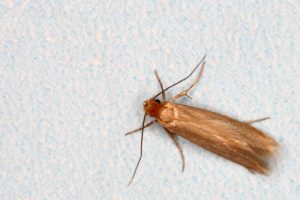Controlling Clothes Moths
By Chris Williams on April 19, 2011.
Q. I’ve been keeping all my oriental rugs in an unused guest room. No one goes in there very often. I noticed small moths walking on the rolled up rugs and webs when I looked closer. They were all over the place. What are these moths doing on my rugs? We have wool rugs all over the house and I’m concerned.
A. Small moths walking on the rugs and the presence of webbing indicates clothes moths. Clothes moths are small(6mm) with a yellowish or golden appearance. The narrow wings are fringed with long hairs. Clothes moths are not attracted to light and prefer dimly lit or dark areas. Adult moths do not feed, but the larvae feed on a variety of materials. Substances of animal and vegetable origin including fabrics may be damaged. Organic material trapped in fabrics provides nutrition for the hungry larvae. Damage to household goods such as clothing, carpets, rugs, furs, fabrics, blankets, stored wool products has been observed. These insects have the rare ability to consume keratin, a material found in wool. Clothes moths have also been found feeding in animal and insect nests within structures.

There are two species of clothes moths. The Webbing clothes moth(Tineola bisselliella) is the most common species found in the Northeast, although found throughout the country. Casemaking clothes moths(Tinea pellionella) are more common in southern states but are also widespread. Both species are similar in appearance and size (wings of newly emerged casemaking clothes moth have 3 dark spots on the forewings). Webbing clothes moth larvae spin small strands of silk into tubes or mats and may move about “naked” for several days before producing any webbing. This material accumulates as the population builds up. Casemaking clothes moths larvae spin little cases that they reside in and the head pops out to feed. The early stages of he larvae are dark in color, when removed from the case. In large infestations casemaking clothes moth larvae may walk up walls in great numbers with their cases attached.
It sounds like you have encountered an infestation of the webbing clothes moth, a very destructive pest. Damage usually takes place in dark, hidden areas, like under furniture or inside closets and dressers rarely opened. Piles of old rugs are another common site of infestation, the rolled up rugs provide darkness and a multitude of food. In severe infestations webbing material builds up in cracks and between layers of fabric being consumed. Webbing clothes moth adults are very active. In nature adults seek out pollen, hair, feathers, wool, fur, dead insects, and dried animal remains. Able to fly considerable distances, adults may enter a building through cracks, open doors, poorly fitting screens, and attic venting in search of suitable locations to lay eggs. They are not attracted to light, and egg carrying females are weak flyers. Over a period of about 2-3 weeks, the females lay 40 to 50 eggs singly or in groups. Once all of her eggs have been attached to fibers of the infested material the female dies. Eggs hatch in 4-10 days in warmer months, while taking as long a three weeks or more in colder temperatures. Newly hatched larvae are about 1mm long, and white in color. Some larvae walk about unprotected, others spin a small silk tube mixed with fiber fragments, fecal pellets, and cast skins. Some larvae make little tufts or mats of this material under which they crawl around and feed. Molting of the larvae depends on temperature, humidity, and type of substrate they are feeding on. The larval period may last from 35 days to over 2 years. Full grown larvae are 12mm long and shiny, creamy white in color. Pupation takes place in a cocoon made of silken strands, fibers, and fecal pellets. Also dependant on temperature and humidity, pupation periods vary from 8-10 days in summer, and more than 4 weeks in winter. The entire life cycle takes place in in 50-90 days but may take up to 4 years in some conditions.
Control of clothes moths (these recommendations will be effective for both species) starts with thorough cleaning. Vacuuming corners, cracks, crevices, and under furniture will remove accumulations of lint, animal fur, hair, dead skin, and other clothes moth food materials. Cleaning out closets, removing animal and insect nests, animal carcasses, utilizing sealed storage containers, dry cleaning, rug cleaning, steam cleaning, beating, and exposure to sun light, will all reduce clothes moth activity. Rotating the position of rugs will kill the fragile larvae by exposing them to sunlight (a natural killer of clothes moth larvae) and foot traffic. Stored wool clothing and blankets should be inspected an laundered periodically. Upholstered furniture, animal specimens, furs, feathers, and mounted trophies should be inspected for signs of infestation. Storage of materials susceptible to clothes moth damage is critical. Sealed containers, tied or Ziploc plastic storage bags, and sealed trunks will prevent infestation. Moth balls may be of some use. Dry cleaning kills all stages of clothes moth as well as professional rug cleaning. Some establishments offer rug cleaning and storage. Pest Control Professionals are licensed to make safe and effective treatments to control clothes moths. Specific treatment varies depending on conditions at the site of infestation, but the above mentioned control and cultural practices are where any Integrated Pest Management plan would start. Colonial Pest Control would be happy to come out and look at your rugs. We would identify the pest involved and make recommendations from there. There is no reason to let clothes moths take over your home.